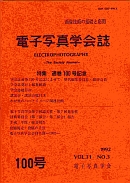Volume 29, Issue 2
Displaying 1-17 of 17 articles from this issue
- |<
- <
- 1
- >
- >|
-
1990Volume 29Issue 2 Pages 112-117
Published: 1990
Released on J-STAGE: March 14, 2008
Download PDF (1920K) -
1990Volume 29Issue 2 Pages 118-124
Published: 1990
Released on J-STAGE: March 14, 2008
Download PDF (1095K) -
1990Volume 29Issue 2 Pages 125-132
Published: 1990
Released on J-STAGE: March 14, 2008
Download PDF (1162K) -
1990Volume 29Issue 2 Pages 133-137
Published: 1990
Released on J-STAGE: March 14, 2008
Download PDF (623K) -
1990Volume 29Issue 2 Pages 138-147
Published: 1990
Released on J-STAGE: March 14, 2008
Download PDF (2415K) -
1990Volume 29Issue 2 Pages 148-155
Published: 1990
Released on J-STAGE: March 14, 2008
Download PDF (3876K) -
1990Volume 29Issue 2 Pages 156-163
Published: 1990
Released on J-STAGE: March 14, 2008
Download PDF (912K) -
1990Volume 29Issue 2 Pages 165-171
Published: 1990
Released on J-STAGE: March 14, 2008
Download PDF (2766K) -
1990Volume 29Issue 2 Pages 172-179
Published: 1990
Released on J-STAGE: March 14, 2008
Download PDF (3467K) -
1990Volume 29Issue 2 Pages 180-187
Published: 1990
Released on J-STAGE: March 14, 2008
Download PDF (2196K) -
1990Volume 29Issue 2 Pages 188-196
Published: 1990
Released on J-STAGE: March 14, 2008
Download PDF (2477K) -
1990Volume 29Issue 2 Pages 197-204
Published: 1990
Released on J-STAGE: March 14, 2008
Download PDF (2744K) -
1990Volume 29Issue 2 Pages 205-213
Published: 1990
Released on J-STAGE: March 14, 2008
Download PDF (3540K) -
1990Volume 29Issue 2 Pages 214-220
Published: 1990
Released on J-STAGE: March 14, 2008
Download PDF (2336K) -
1990Volume 29Issue 2 Pages 221-229
Published: 1990
Released on J-STAGE: March 14, 2008
Download PDF (4257K) -
1990Volume 29Issue 2 Pages 230-234
Published: 1990
Released on J-STAGE: March 14, 2008
Download PDF (642K) -
1990Volume 29Issue 2 Pages 235-240
Published: 1990
Released on J-STAGE: March 14, 2008
Download PDF (1670K)
- |<
- <
- 1
- >
- >|
